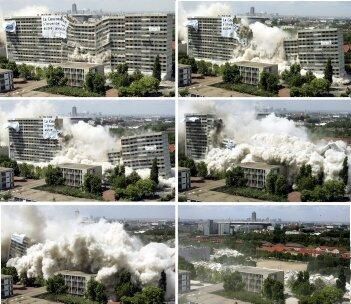
I am often desperate to see that some excellent authors of "resistance" are being used by the forces they were fighting against in the first place (not to talk about the tremenduous amount of 60's rock songs which are now systematically used in commercials !). What I (We?) forgot sometimes is that we can do the same thing: DETOURNER as the Situationists would put it.
So here is the book all offered to the Detournement since an architect who would like some simple solutions to create an environment less based on paranoia would just have to design the contrary of what it advocates. Its author, Barry Poyner wanted Design against Crime to be a kind of sequel of Defensible Space written in 1972 by Oscar Newman. Without ever making a distinction between homicide, robbery, burglary and vandalism, Poyner's thesis is that "the layout of neighbourhoods, the form of streets, the design of housing and the planning of schools can be said to contribute to the likelihood of crime”
At the beginning of the book he recalls the four Newman's principles to invent controlled and secured public housings:
1. Territoriality: The sub-division and zoning of communal space in and around residential building to promote proprietary attitudes among residents.
2. Natural Surveillance: The positioning of apartment windows to allow residents to naturally survey the exterior and interior public areas of their living environment.
3. Image: The use of building forms and idioms to avoid the stigma of public housing.
4. Milieu: Locating residential projects to face onto areas of the city considered safe (such as heavily-trafficked streets, institutional areas and government offices).
He also advocate for the suppression of semi-public environment (like decks, platforms, galleries etc.) and even more radically for a regulation of children density in residences (!!!):
“Wilson pointed out that efforts were already being made to allocate new tenants to housing with this in mind. Also, where local authorities are rehabilitating older blocks, modifications can be made to change the size of units to achieve mixes of one-, two-, and three bedroom dwellings. No clear guideline can be given for recommending maximum child densities. The study by Wilson defined blocks with low child densities as containing an average of three or less children per ten dwellings, but this would be too stringent as a guideline for housing allocation policies. However, what might be a more realistic approach would be to limit allocation of new tenancies in blocks with large amounts of unsupervisable communal space to all-adult households.”
Each scale is being studied and optimized for the sake of security. From the urban organization of a residential district to the door's material via anti-burglary houses, anti-pickpockets markets and anti-vandalism schools. A nauseous vision of a seamless world where rich are not being stolen and poors remain calm in their public housing...
The foreword says it all; it is written by the main commissioner of London's police who thanks Poyner for his work...see below.










 Deconcrete recently released an article about Thomas Wrede's composed landscape photographs entitled Real Landscapes which dramatizes tracks of artefacts in extreme geological terrains. The shift of scale is important here since it opens the opportunity of discovering new landscapes in the micro-scale just like David Linch suggested in the opening of Blue Velvet...
Deconcrete recently released an article about Thomas Wrede's composed landscape photographs entitled Real Landscapes which dramatizes tracks of artefacts in extreme geological terrains. The shift of scale is important here since it opens the opportunity of discovering new landscapes in the micro-scale just like David Linch suggested in the opening of Blue Velvet...



 Playing the building
Playing the building




 Rue Abu Jamil
Rue Abu Jamil







































